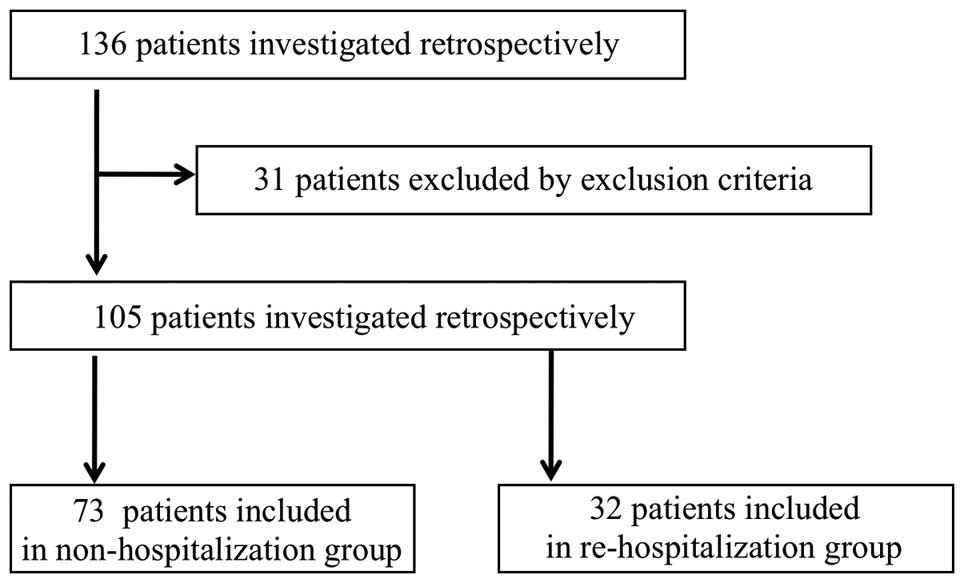|
1
|
Bosly A, Bron D, Van Hoof A, De Bock R,
Berneman Z, Ferrant A, Kaufman L, Dauwe M and Verhoef G:
Achievement of optimal average relative dose intensity and
correlation with survival in diffuse large B-cell lymphoma patients
treated with CHOP. Ann Hematol. 87:277–283. 2008. View Article : Google Scholar : PubMed/NCBI
|
|
2
|
Pettengell R, Schwenkglenks M and Bosly A:
Association of reduced relative dose intensity and survival in
lymphoma patients receiving CHOP-21 chemotherapy. Ann Hematol.
87:429–430. 2008. View Article : Google Scholar : PubMed/NCBI
|
|
3
|
Trillet-Lenoir V, Green J, Manegold C, Von
Pawel J, Gatzemeier U, Lebeau B, Depierre A, Johnson P, Decoster G,
Tomita D, et al: Recombinant granulocyte colony stimulating factor
reduces the infectious complications of cytotoxic chemotherapy. Eur
J Cancer. 29A:319–324. 1993. View Article : Google Scholar : PubMed/NCBI
|
|
4
|
Aapro MS, Bohlius J, Cameron DA, Dal Lago
L, Donnelly JP, Kearney N, Lyman GH, Pettengell R, Tjan-Heijnen VC,
Walewski J, et al: 2010 update of EORTC guidelines for the use of
granulocyte-colony stimulating factor to reduce the incidence of
chemotherapy-induced febrile neutropenia in adult patients with
lymphoproliferative disorders and solid tumours. Eur J Cancer.
47:8–32. 2011. View Article : Google Scholar : PubMed/NCBI
|
|
5
|
Lyman GH, Morrison VA, Dale DC, Crawford
J, Delgado DJ and Fridman M: OPPS Working Group and ANC Study
Group: Risk of febrile neutropenia among patients with
intermediate-grade non-Hodgkin's lymphoma receiving CHOP
chemotherapy. Leuk Lymphoma. 44:2069–2076. 2003. View Article : Google Scholar : PubMed/NCBI
|
|
6
|
Pettengell R, Bosly A, Szucs TD, Jackisch
C, Leonard R, Paridaens R, Constenla M and Schwenkglenks M: Impact
of Neutropenia in Chemotherapy-European Study Group (INC-EU):
Multivariate analysis of febrile neutropenia occurrence in patients
with non-Hodgkin lymphoma: Data from the INC-EU prospective
observational European neutropenia study. Br J Haematol.
144:677–685. 2009. View Article : Google Scholar : PubMed/NCBI
|
|
7
|
Smith TJ, Khatcheressian J, Lyman GH, Ozer
H, Armitage JO, Balducci L, Bennett CL, Cantor SB, Crawford J,
Cross SJ, et al: 2006 update of recommendations for the use of
white blood cell growth factors: An evidence-based clinical
practice guideline. J Clin Oncol. 24:3187–3205. 2006. View Article : Google Scholar : PubMed/NCBI
|
|
8
|
Oken MM, Creech RH, Tormey DC, Horton J,
Davis TE, McFadden ET and Carbone PP: Toxicity and response
criteria of the Eastern Cooperative Oncology Group. Am J Clin
Oncol. 5:649–655. 1982. View Article : Google Scholar : PubMed/NCBI
|
|
9
|
Armitage JO: Staging non-Hodgkin lymphoma.
CA Cancer J Clin. 55:368–376. 2005. View Article : Google Scholar : PubMed/NCBI
|
|
10
|
Aapro MS, Cameron DA, Pettengell R,
Bohlius J, Crawford J, Ellis M, Kearney N, Lyman GH, Tjan-Heijnen
VC, Walewski J, et al: The European Organisation for Research and
EORTC guidelines for the use of granulocyte-colony stimulating
factor to reduce the incidence of chemotherapy-induced febrile
neutropenia in adult patients with lymphomas and solid tumours. Eur
J Cancer. 42:2433–2453. 2006. View Article : Google Scholar : PubMed/NCBI
|
|
11
|
Smith TJ, Khatcheressian J, Lyman GH, Ozer
H, Armitage JO, Balducci L, Bennett CL, Cantor SB, Crawford J,
Cross SJ, et al: 2006 update of recommendations for the use of
white blood cell growth factors: An evidence-based, clinical
practice guideline. J Clin Oncol. 24:3187–3205. 2006. View Article : Google Scholar : PubMed/NCBI
|
|
12
|
Balducci L, Al-Halawani H, Charu V, Tam J,
Shahin S, Dreiling L and Ershler WB: Elderly cancer patients
receiving chemotherapy benefit from first-cycle pegfilgrastim.
Oncologist. 12:1416–1424. 2007. View Article : Google Scholar : PubMed/NCBI
|
|
13
|
Case DC Jr, Desch CE, Kalman LA, Vongkovit
P, Mena RR, Fridman M and Allen B: Community-based trial of R-CHOP
and maintenance rituximab for intermediate- or high-grade
non-Hodgkin lymphoma with first-cycle filgrastim for older
patients. Clin Lymphoma Myeloma. 7:354–360. 2007. View Article : Google Scholar : PubMed/NCBI
|
|
14
|
Crawford J, Dale DC, Kuderer NM, Culakova
E, Poniewierski MS, Wolff D and Lyman GH: Risk and timing of
neutropenic events in adult cancer patients receiving chemotherapy:
The results of a prospective nationwide study of oncology practice.
J Natl Compr Canc Netw. 6:109–118. 2008.PubMed/NCBI
|
|
15
|
Pettengell R, Schwenkglenks M, Leonard R,
Bosly A, Paridaens R, Constenla M, Szucs TD and Jackisch C: Impact
of Neutropenia in Chemotherapy-European Study Group (INC-EU):
Neutropenia occurrence and predictors of reduced chemotherapy
delivery: Results from the INC-EU prospective observational
European neutropenia study. Support Care Cancer. 16:1299–1309.
2008. View Article : Google Scholar : PubMed/NCBI
|
|
16
|
Salar A, Haioun C, Rossi FG, Duehrsen U,
Pettengell R, Johnsen HE, Jaeger U, Verhoef G, Schwenkglenks M,
Bacon P, et al: The need for improved neutropenia risk assessment
in DLBCL patients receiving R-CHOP-21: Findings from clinical
practice. Leuk Res. 36:548–553. 2012. View Article : Google Scholar : PubMed/NCBI
|
|
17
|
Mayordomo JI, López A, Viñolas N,
Castellanos J, Pernas S, Alonso Domingo J, Frau A, Layola M,
Antonio Gasquet J and Sánchez J: ENIA Study Group: Retrospective
cost analysis of management of febrile neutropenia in cancer
patients in Spain. Curr Med Res Opin. 25:2533–2542. 2009.
View Article : Google Scholar : PubMed/NCBI
|
|
18
|
Lyman GH and Delgado DJ: Risk and timing
of hospitalization for febrile neutropenia in patients receiving
CHOP, CHOP-R, or CNOP chemotherapy for intermediate-grade
non-Hodgkin lymphoma. Cancer. 98:2402–2409. 2003. View Article : Google Scholar : PubMed/NCBI
|
|
19
|
Morstyn G, Foote MA, Walker T and Molineux
G: Filgrastim (r-metHuG-CSF) in the 21st century: SD/01. Acta
Haematol. 105:151–155. 2001. View Article : Google Scholar : PubMed/NCBI
|
|
20
|
Lord BI, Woolford LB and Molineux G:
Kinetics of neutrophil production in normal and neutropenic animals
during the response to filgrastim (r-metHu G-CSF) or filgrastim
SD/01 (PEG-r-metHu G-CSF). Clin Cancer Res. 7:2085–2090.
2001.PubMed/NCBI
|















